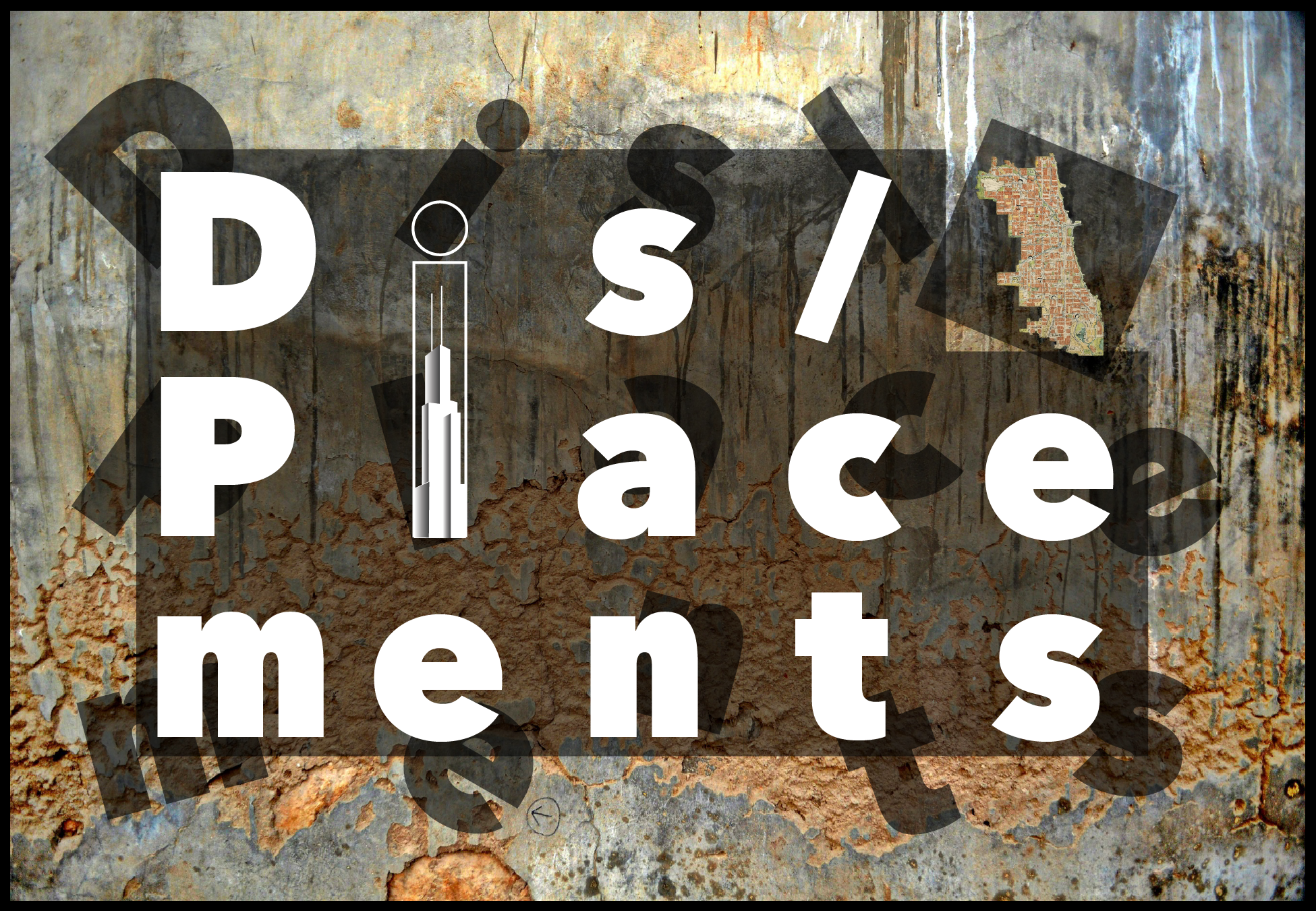Block Party Mural
“Block Party” Mural
Inspired by conversations with members of the Winthrop Family and research in the Dis/Placements Project archive, the artist Tia Etu conceptualized and painted this mural with assistance from Anjali Pride, titled “Block Party,” which is located in the Winthrop Historical Garden. The Winthrop Historical Garden was originally established by NeighborSpace thanks to the efforts of community members such as the late Joyce Dugan and Deborah Baumgartner. It was dedicated in 2009 by then alderperson Helen Shiller. The garden was re-dedicated in 2022 by then Mayor Lori Lightfoot after it was redesigned by the landscape architecture firm MKSK through a City of Chicago Public Outdoor Plaza (POP!) grant. The mural itself was also funded by a POP! grant that Uptown United facilitated. The mural project began in Spring 2024 and was completed in Fall 2024.











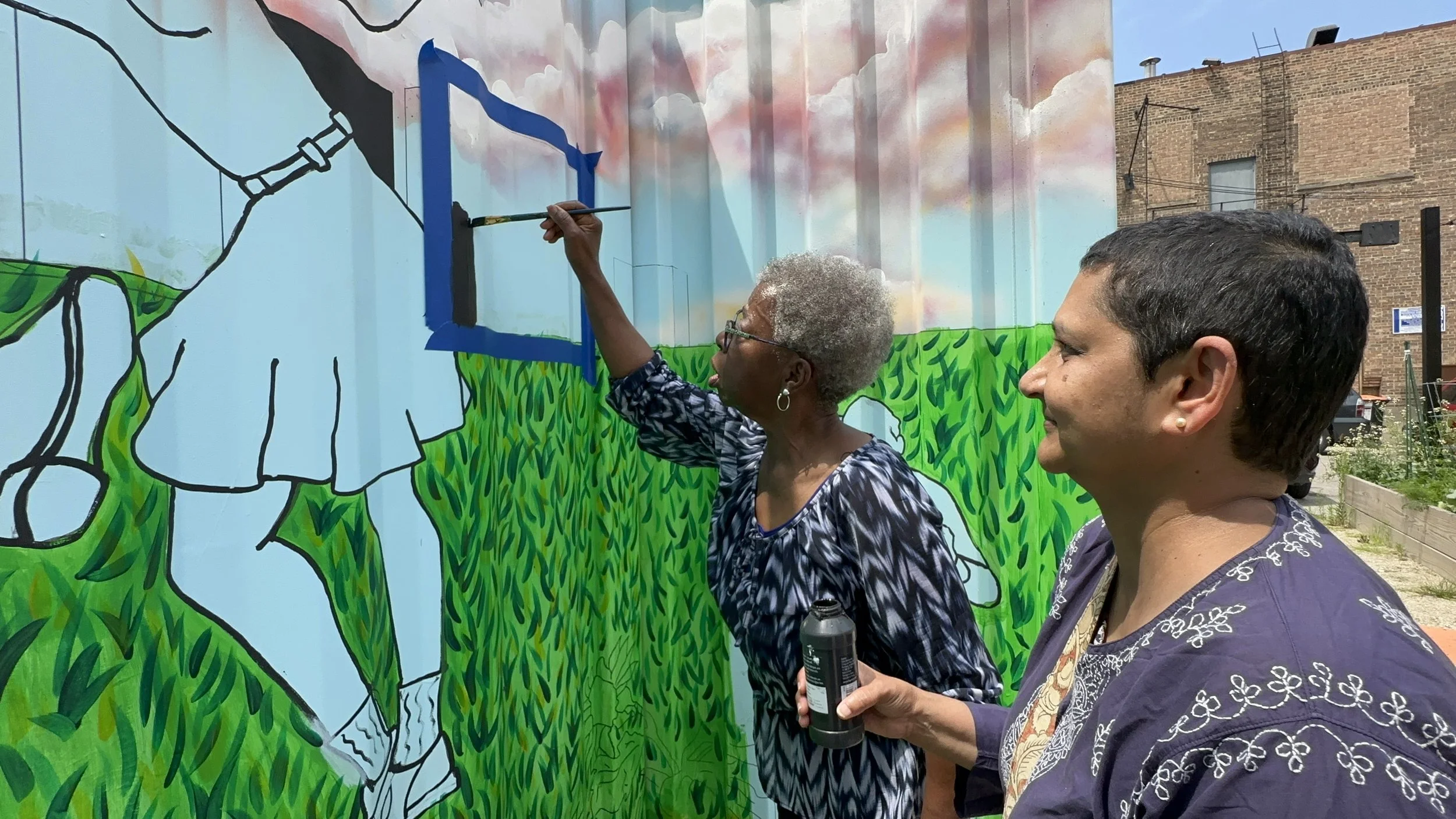
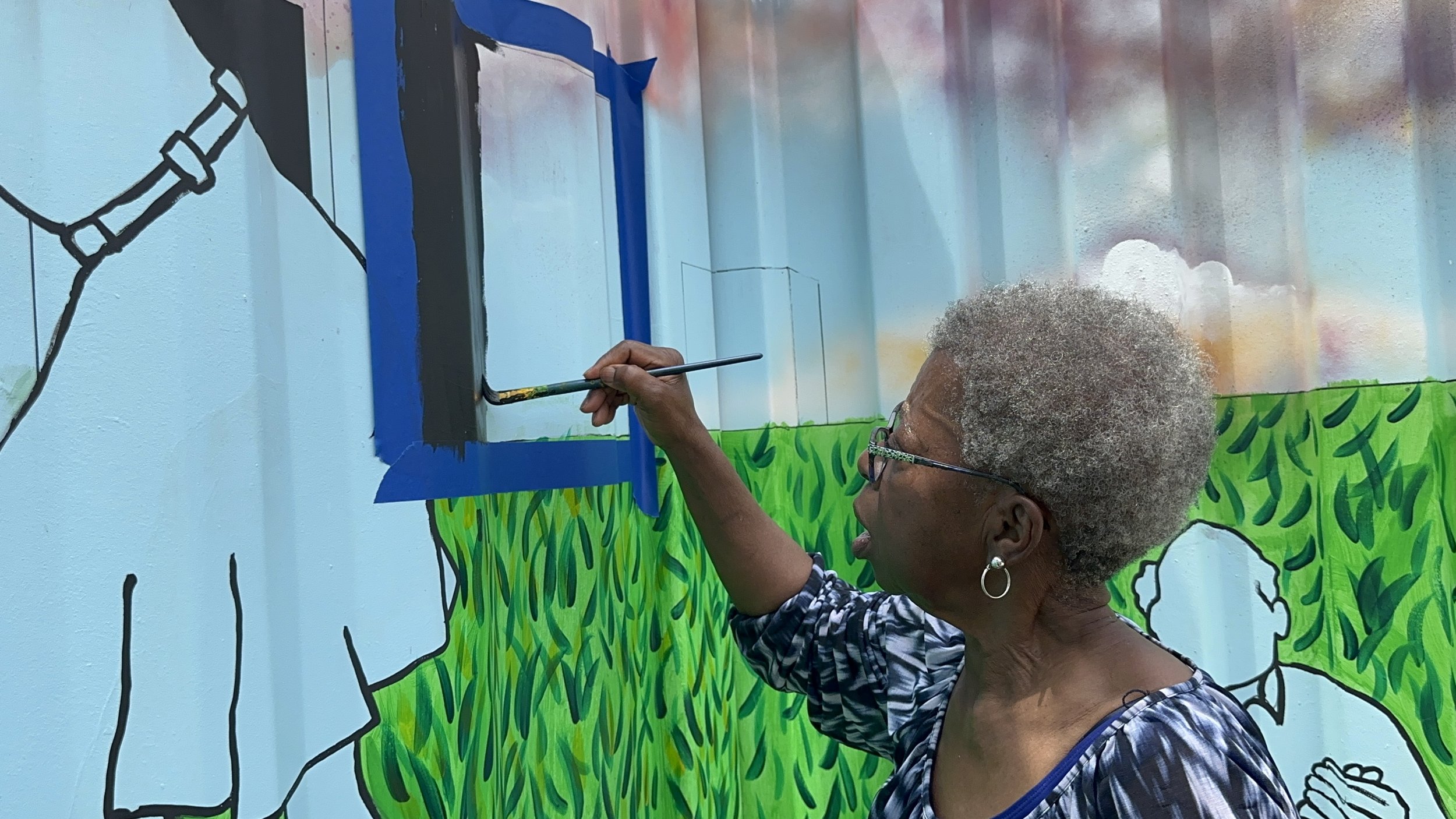















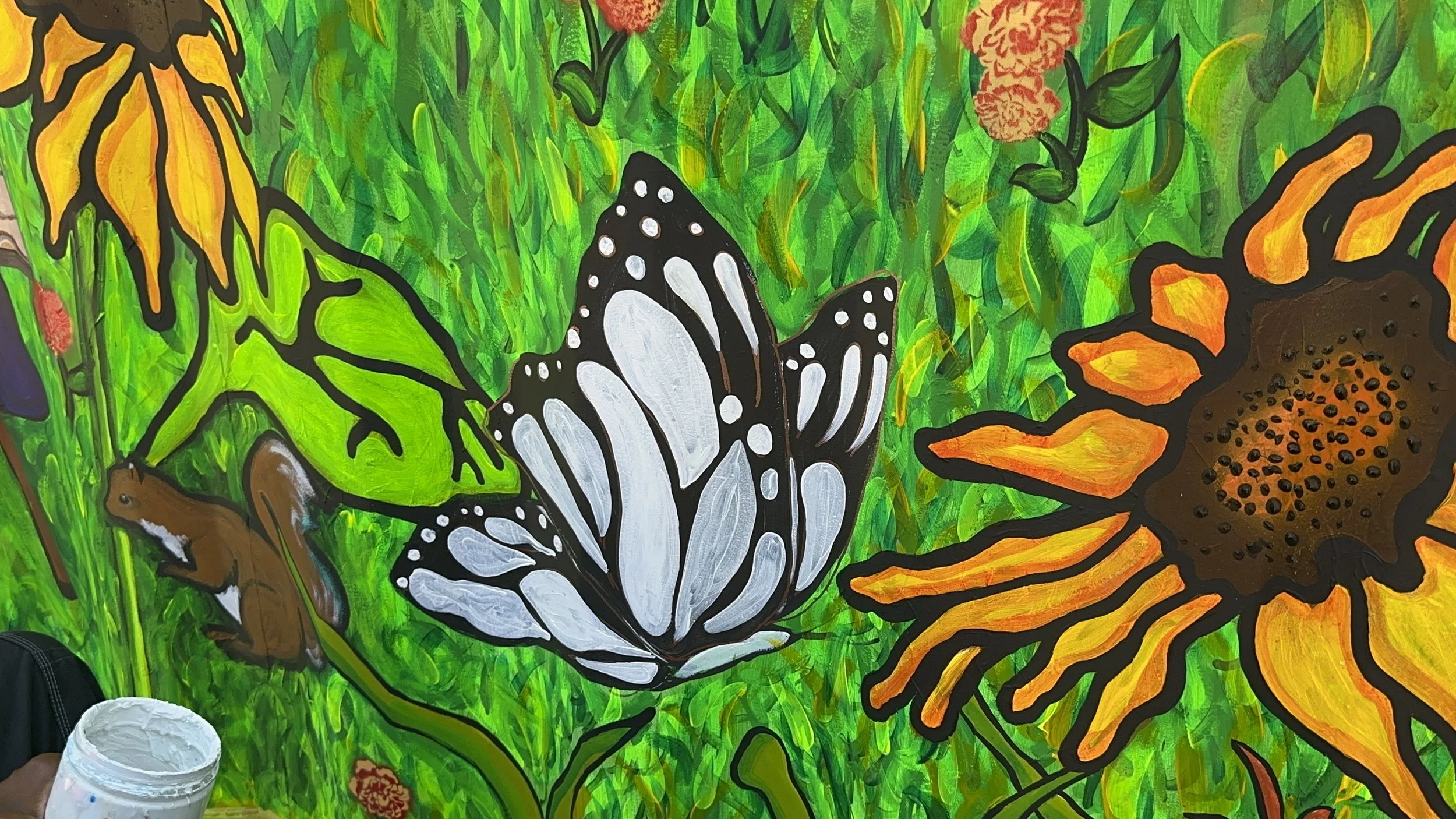



















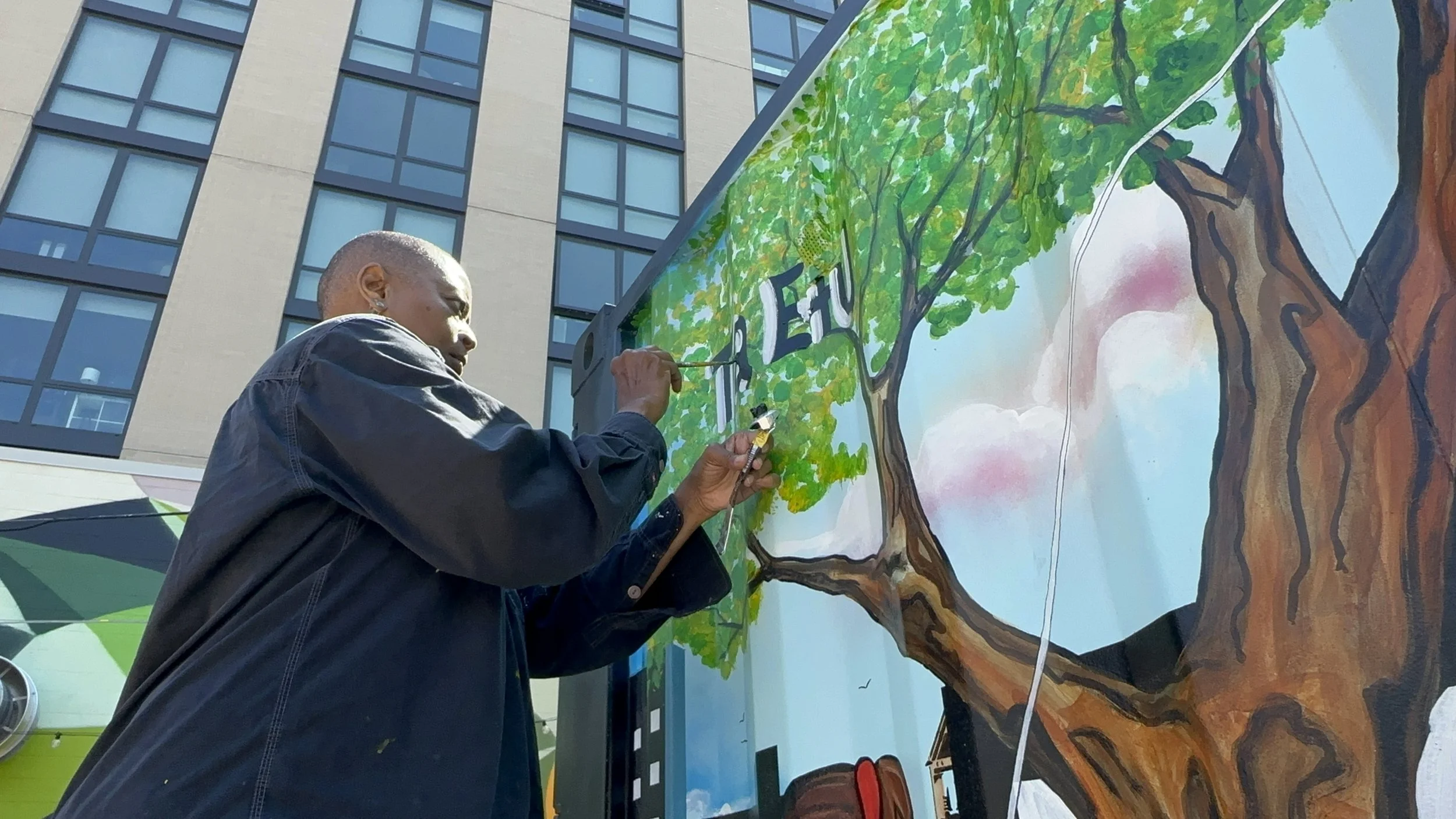

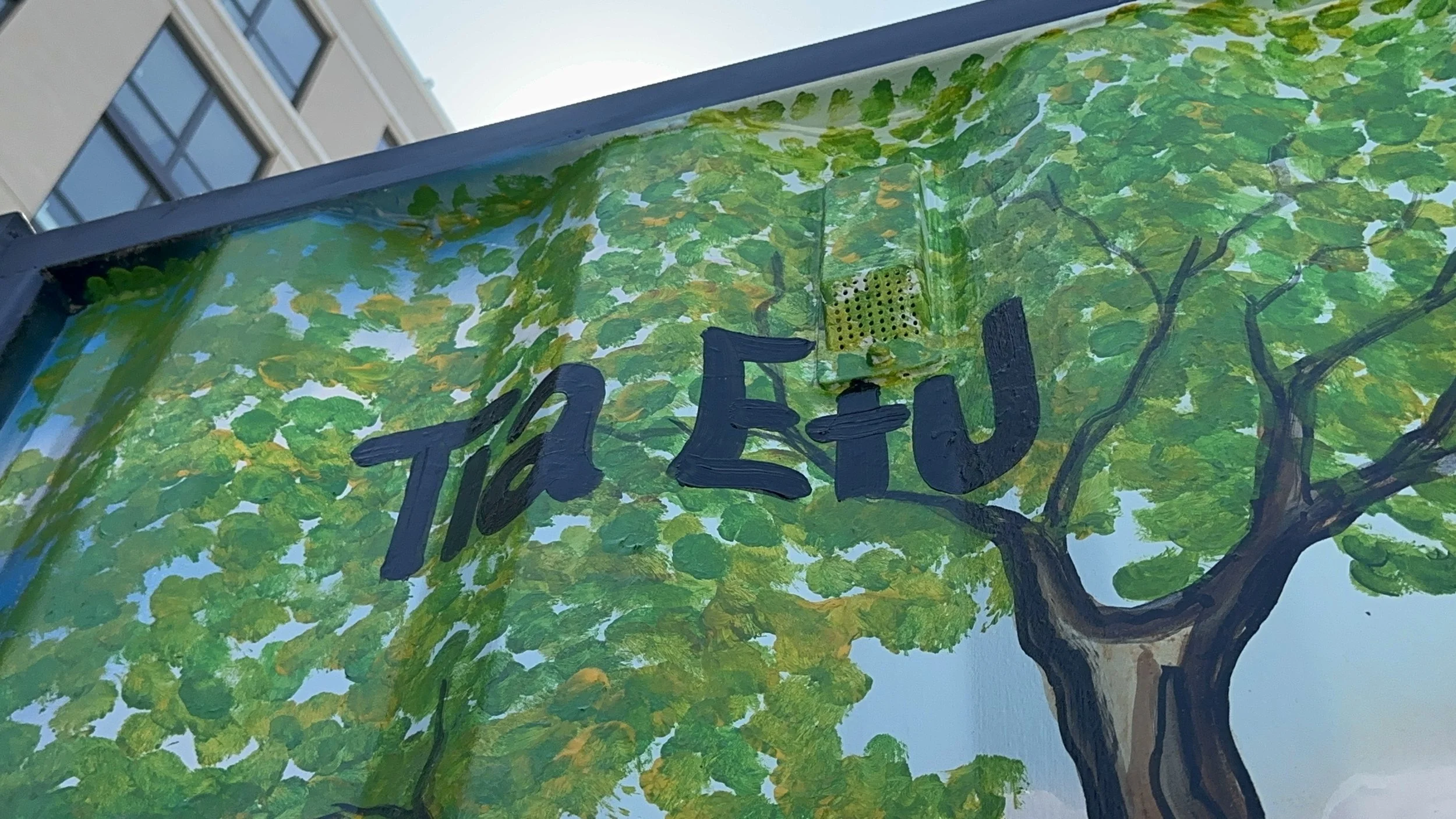







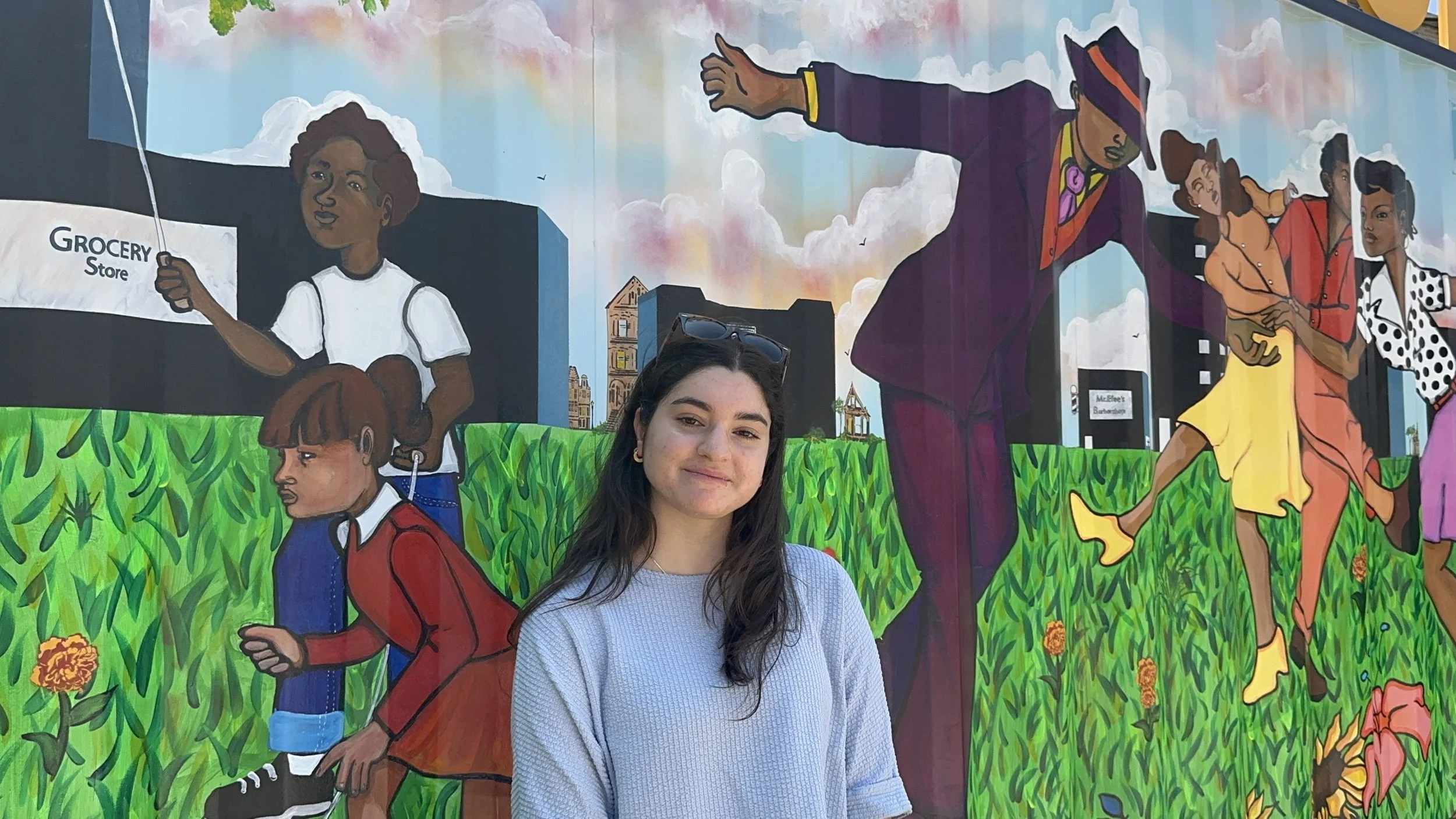

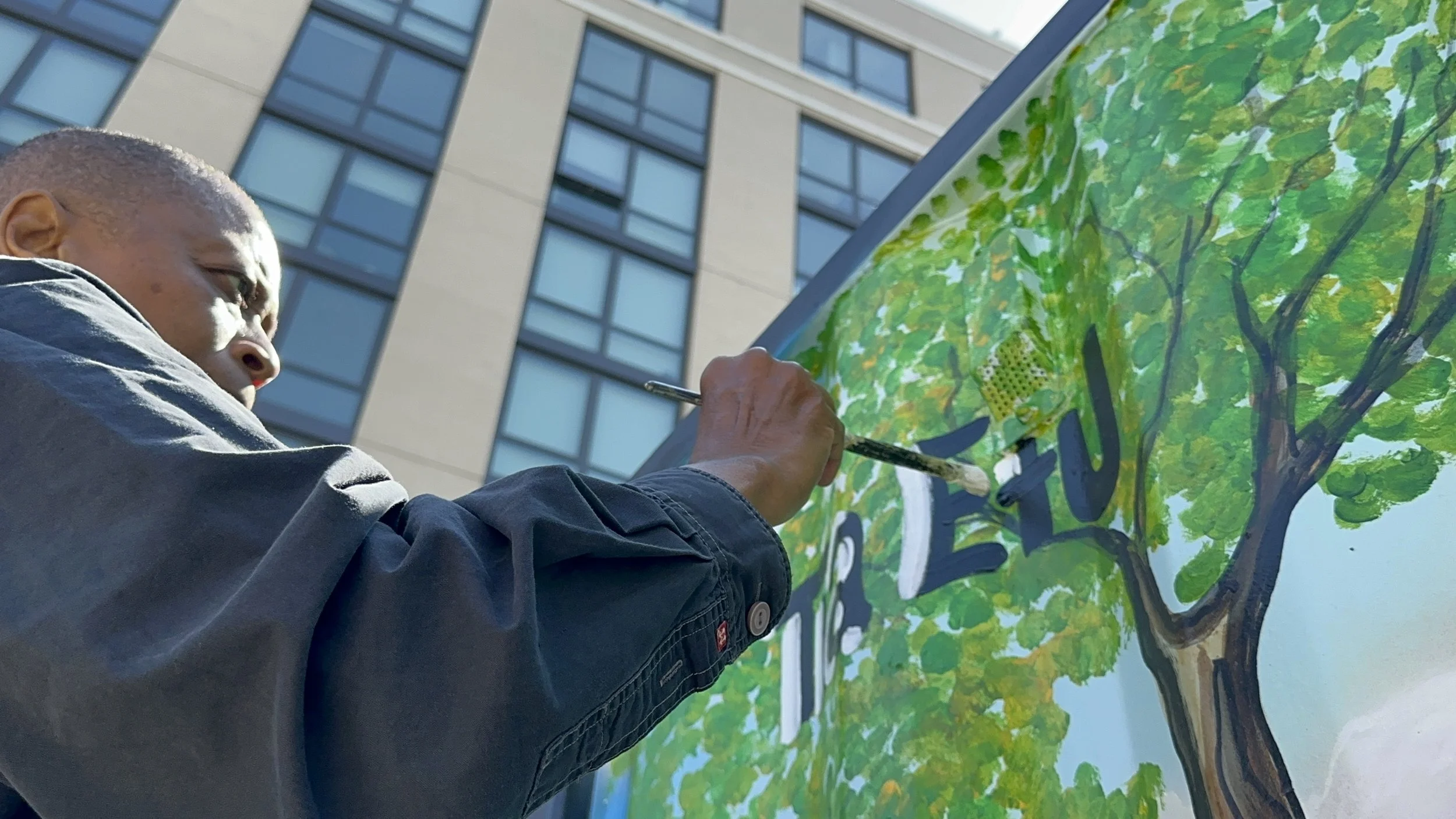






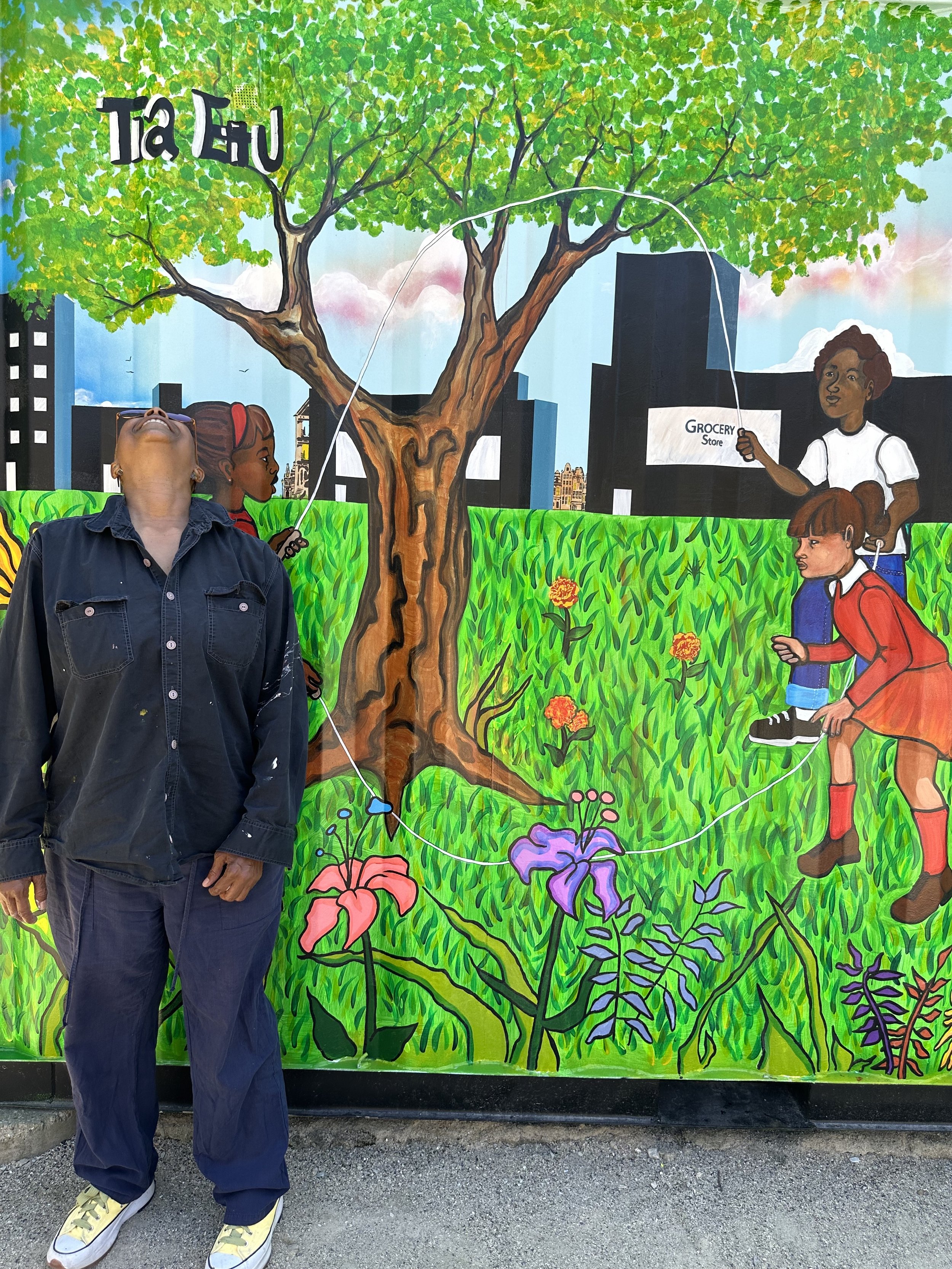






Interview with artist: TIA ETU
Anna and Gayatri: Thank you, Tia for joining us today. Could you start today by introducing yourself?
Tia: My name is Tia Etu. I am a professional artist. I do murals, sculptures, portraits, jewelry, whatever comes to mind, which is the name of my studio (https://whatevercomestomind.com) . I am a graduate of the School of the Art Institute in Chicago. I work on projects that hope to capture the complexities of the human spirit and give that sense of human longing, desire, pain, and pleasure. My lifelong endeavor is to create art to improve the quality of the human experience. I am a muralist but have also done work with different media. You can see some of my projects on my website.
Anna and Gayatri: How did you learn about this Winthrop Garden mural project?
Tia: I learned about the project through some friends of mine – from both of you! I learned that you two had been working on researching, documenting, and sharing the stories of the Winthrop Family. As I understand it, there was a period when African Americans who lived in Uptown were only allowed to live on this one block – the 4600 block- of Winthrop Avenue. These families formed a tight knit bond and called themselves the Winthrop Family. You presented me with an opportunity to paint a mural that would capture and be dedicated to this history.
Anna and Gayatri: Can you walk us through the conceptualization of this mural?
Tia: I began by researching the family’s history. I got a lot of information from the work you’ve done with the Winthrop family that is documented on the Dis/Placements website. You then helped arrange zoom meetings with members of the Winthrop Family last March so that I could meet and talk with them about what they would like to see on the mural. I asked family members what they want to see. I shared with them what I learned from my research. I tried to incorporate their perspectives and wishes on this design. After that meeting, I started to sketch a few ideas that came to mind based on that conversation and my research. I then shared that design with you and with Uptown United.
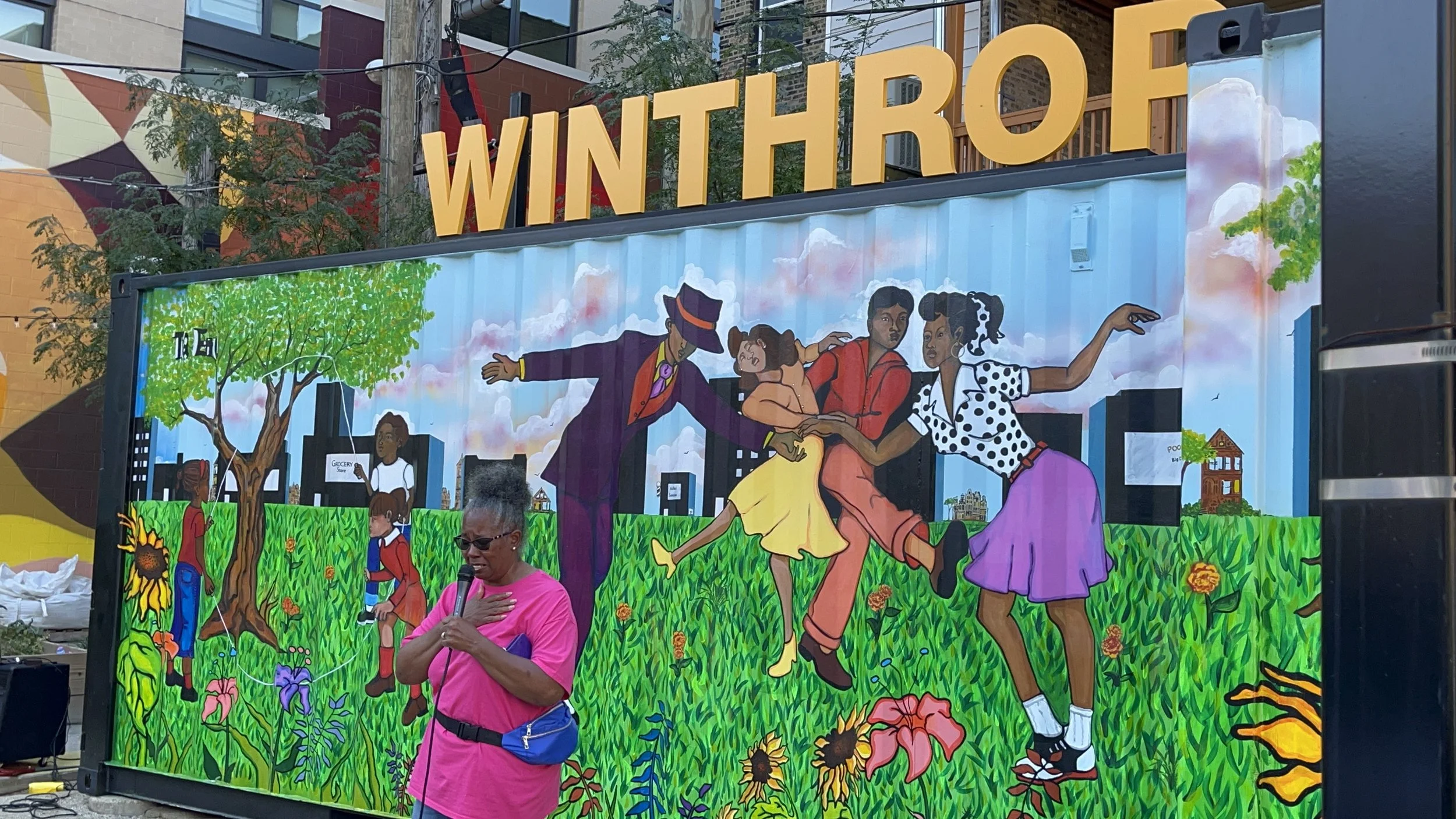













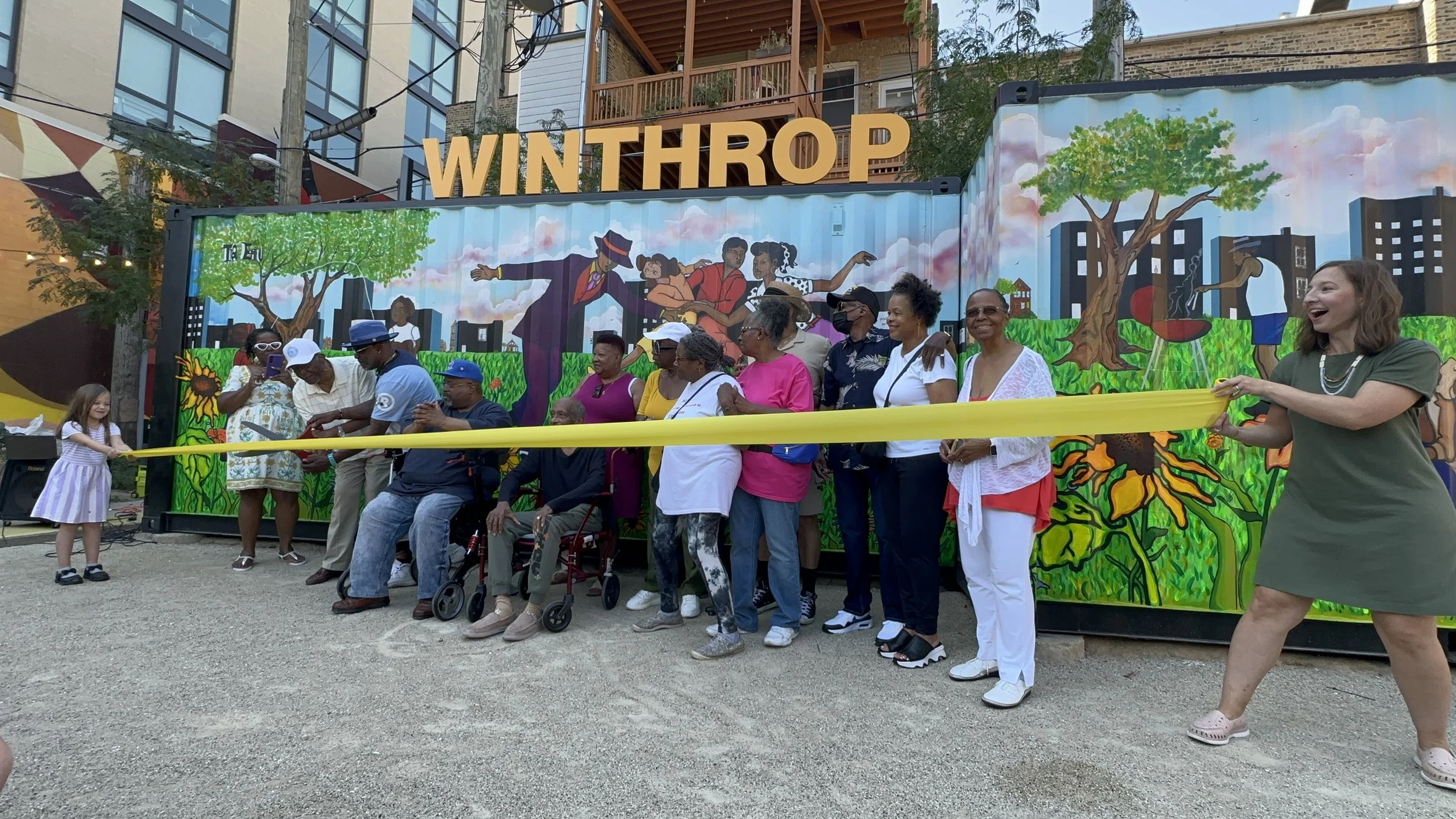
Anna and Gayatri: Based on that meeting with the Winthrop family members, and the research that you’ve done about the family, what did you learn and how did those insights make it to the individual elements of your mural?
Tia: The Winthrop Family said they enjoyed the children’s playground so you can see a group of children playing here on this mural. They loved block parties, and that sentiment is mirrored here with a group of people dancing. In fact, given how central that was to the community they formed on this block, I have titled the mural ‘The Block Party.’ The Winthrop family wanted me to incorporate different ages - from the youngsters to the elderly – so you can see a range of generations on this mural. As the three of us discussed, we incorporated the buildings that they remember. Thank you for your help with locating all this information. For example, there is a barbershop here. They don’t remember the name of the barbershop, but they remember the barber who ran the shop who they thought was very handsome – Mr. Efee. So, when they see it, they’ll say, “Oh yeah, there’s Mr. Efee’s barbershop!” There’s the grocery store. As you know, we didn’t put the name of the grocery store since it was unclear how they treated the family. There was a tavern called the 1107 Club. And there was a pool hall. And what they told me was that as kids, they used to peek inside the window because they always wanted to go in. So, on the mural, you can see a child hanging onto a window trying to look inside. The Winthrop Family did not mention barbecues, but I know my people. So, I included a man who is working a barbecue because that is something you will often see in my community.
So, I wanted people to get a beautiful feeling while looking at this mural even though the story of segregation is quite sad. The reason they had all these things on the block is because they were not allowed to leave this block. On this piece, you see small houses in the back and those are the houses where affluent people – some of whom were the ones who restricted them to live on this block - lived. So, they created their own world. They even had a Sunday church in the basement of a building and here I put it in Mr. Efee’s barbershop (marked with a cross). We have all sorts of symbols like the marigolds to honor Ma Sophie – one of the matriarchs of the block. Ma Sophie loved marigolds. We wanted to honor the restaurants that were on the block – the Divine Slum Clearance restaurant and Collier’s Chicken. I try to capture the sentiment of care and love with the elders you see on this mural. You see an elderly couple dancing in the park. And an elderly couple sitting on a bench. Back in the day, we did everything in the park.
Anna and Gayatri: When did you start the project?
Tia: I began the research for this project in Spring 2024, which included meeting with the Winthrop Family and then putting together my painting team. In terms of painting, we t took us a month and two weeks – from July 8 to August 23 - to paint the mural. But we did not always go every day and took a break during the weekends. When we started, we were only working on the mural for two hours. Then on some days, we worked more hours. We dealt with all the environmental elements – from the heat, the wind, the insects who seem to like our company.
Anna and Gayatri: When people look at the mural, what do you want them to see?
Tia: I want them to feel the pleasure of it. But I want them to know the full story. I want them to know about the research that you have all done to tell this story, this history. I want people to know that life on the block was not just about people having fun. It’s about people doing the best they could under the circumstances of their lives, the racism and segregation that surrounded them – while capturing caring, community, happiness. I want people to feel the joy the Winthrop family felt amidst the enclosure that they lived in. They are making the best of their situation. Their soul and their spirit are not lost. Even though they were like prisoners in this area, they had not lost their spirit.
Anna and Gayatri: Earlier, you were also saying something about capturing “paradise.” Could you say a little more about that?
Tia: I painted the Victorian style houses in the back to evoke a kind of paradise where the affluent people lived in mansions with manicured lawns and perfectly trimmed trees and bushes. These homes were probably maintained by servants. I put the sun by them, along with birds flying around. Every building has a yellow light in them – and that represents their “watchful” eyes to make sure that people on the Winthrop block don’t leave their area. The houses on the block that are black in color look like boxes because I want them to evoke a sense of being boxed in; nothing fancy like these other houses, which is what the Winthrop family experienced. They were stranded in this area – or an island – in some ways. So, they had no choice, but they also made it beautiful. So, in a sense, the Winthrop family also was a paradise. It depends on one’s perspective. So, this mural is also asking – what is paradise? And whose paradise?
Anna and Gayatri: We noticed silhouettes of figures behind the glass of a few of the windows. Could you say a little more about what you were trying to convey there?
Tia: Once people get to know the story of the Winthrop family, I want them to arrive at their own interpretation of who these figures represent. I want them to ask - who is that person standing behind that window? Are they part of the neighborhood? Are they keeping an eye on them? Why are they watching them? So, I want to leave it open-ended.
Anna and Gayatri: What is the name of the mural and tell us how you came to provide this name?
Tia: The name of the mural is “Block Party.” I call it that because it was one of the fondest memories that the Winthrop Family had amidst all of the racism and segregation they experienced. They always found a way to have happiness. And the block party was one of their happiest moments. So, I decided to call the mural Block Party for that reason.
Anna and Gayatri: Thank you, Tia. Is there anything else you’d like to add?
I hope that the Winthrop family will like the mural. And I hope that people will take the time to learn about their history. Both of you (and your students) have done a great job of documenting this through your Dis/Placements project. This is a story that is not just about the block but also about what we might have had in the past in terms of the connections between people, between generations. It is also a story about Chicago, about race, about housing and gentrification. None of the Winthrop families live on the block anymore. That says something too…
Interview conducted on August 23, 2024
Copyright ©2018 Dis/Placements Project